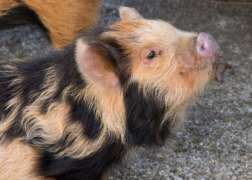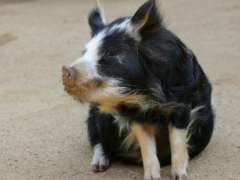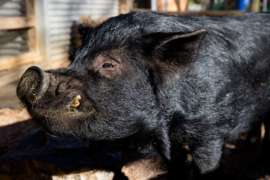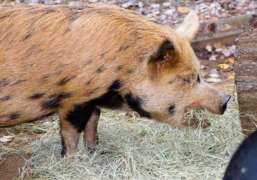Kunekune Pig
Kunekune Pig
Pigs were among one of the very first domesticated animals, and they have been part of human life as companions and sources of food for millennia. Many thousands of years of selective breeding have produced a large of number of breeds specialized for different purposes and climates. Domestic pigs can quickly become established as feral hogs in almost any habitat. In places such as the eastern U.S., where there are no native pigs, feral hogs create significant habitat damage with their foraging behaviors.
Sus scrofa domesticus
Omnivore
New Zealand [VIEW MAP]
Urban Areas
The Kune kune pigs, Aria and Stark, live on habitat at the end of the barn. They have indoor and outdoor space, so sometimes you have to look around to find them. If you are looking forward to petting a kune kune, try visiting on a warm sunny morning when the pigs often get time in the contact yard. Sometimes the pigs want to stay in the yard for hours while other days they only want to take a quick lap then go back to their own habitat. We let them take the lead on where they want to spend their time.
Photos and Videos
The name Kunekune means “fat and round” in Maori. The Maori are native peoples in areas of New Zealand and use these pigs as a source of food at times of feasting. The breed has been maintained for millennia by the native Maori of New Zealand, but their actual origin is still under debate. Some believe that the Maori peoples brought them to the mainland in their canoes; however, it is more likely that they arrived with more recent Asian expeditions. This theory is supported by the presence of the piri piri, a trademark of the Asian domestic pigs, in Kunekunes.
A typical Kunekune (pronounced “cooney cooney”) is short-legged and short-snouted, with a very round body due to high fat percentage. They are smaller than other breeds of pigs found in New Zealand. Kunekunes generally weigh between 120 and 240 pounds and can grow to be up to 30 inches in length.
They have “tassels” called piri piri that hang from their lower jaws. It is a distinctive trait of the breed, even if not all Kunekunes possess it. The coat color varies greatly and includes variations such as black, black-and-white, brown, gold, tan and cream, sometimes with randomly distributed spots and patches of color. Coat texture also varies, ranging from short, silky hair to long, coarse, curly hair. Extensive hair loss in the warmer summer months is common.
These pigs live about 15 years. Females, or sows, reach maturity at about 10 months old and can cycle every 18 to 24 days. Males, or boars, are generally mature at about a year old.
The gestation period is about 116 days. A litter of piglets can number up to 12, but typically ranges from six to eight. Piglets are fully weaned by about 4 months old.
The Kune kune pigs, Aria and Stark, live on habitat at the end of the barn. They have indoor and outdoor space, so sometimes you have to look around to find them. If you are looking forward to petting a kune kune, try visiting on a warm sunny morning when the pigs often get time in the contact yard. Sometimes the pigs want to stay in the yard for hours while other days they only want to take a quick lap then go back to their own habitat. We let them take the lead on where they want to spend their time.
This breed is most closely associated with the Maori people of New Zealand and other Pacific cultures derived from them. In the 1970s, it was thought that Kunekunes were almost extinct. In the late 1970s, a group of dedicated conservationists gathered a stock of nine purebred Kunekunes. From that original stock, they now number in the thousands and can be found in a number of countries worldwide.
At the Zoo, we offer the Kunekune pigs a varied diet of Orchard grass and Bermuda hay, browse (clippings from non-toxic plants across the Zoo), produce and grain.




